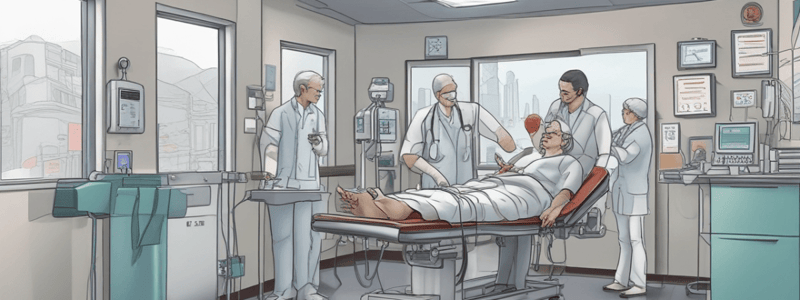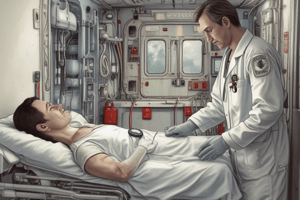Podcast
Questions and Answers
What is the primary purpose of conducting a secondary assessment in patient care?
What is the primary purpose of conducting a secondary assessment in patient care?
- To provide first aid treatment
- To gather comprehensive patient history (correct)
- To administer medication
- To assess vital signs
Which communication technique is NOT recommended during history-taking in patient care?
Which communication technique is NOT recommended during history-taking in patient care?
- Using open-ended questions
- Avoiding leading questions
- Showing empathy
- Using leading questions (correct)
What is the OPQRST method primarily used for in patient assessment?
What is the OPQRST method primarily used for in patient assessment?
- To assess mental health status
- To inquire about pain (correct)
- To evaluate past medical history
- To assess vital signs
In which situation should an unstable patient be reassessed?
In which situation should an unstable patient be reassessed?
What should be considered when addressing sensitive topics like alcohol/drug use in patient care?
What should be considered when addressing sensitive topics like alcohol/drug use in patient care?
Why is it important to gather patient history from various sources before transport?
Why is it important to gather patient history from various sources before transport?
Flashcards are hidden until you start studying
Study Notes
- Secondary assessment follows primary survey in patient care, involving detailed history taking to understand chief complaint, signs, and symptoms
- Importance of gathering comprehensive patient history from various sources like family, friends, and medical tags without delaying transport for unstable patients
- Use appropriate communication techniques during history-taking, including open-ended questions, empathy, and avoiding leading questions
- Assessing pain using OPQRST method, considering factors like onset, provoking factors, quality, radiation, and severity on a scale from 0 to 10
- Inquire about patient interventions before calling 911, identify pertinent negatives, and consider past medical history, allergies, medications, and events
- Address sensitive topics like alcohol/drug use, domestic violence, and sexual history with care and confidentiality
- Assess communication barriers like language barriers and hearing impairments, use interpreters or alternative communication methods
- Conduct a full secondary assessment involving systematic physical examination from head to toe, including vital signs, respiratory, neurological, and musculoskeletal assessments
- Importance of reassessment in patient care to monitor changes in condition, vital signs, response to treatment, and overall improvement or deterioration
- Unstable patients should be reassessed every 5 minutes, while stable patients should be reassessed every 15 minutes to ensure ongoing monitoring and proper care
Studying That Suits You
Use AI to generate personalized quizzes and flashcards to suit your learning preferences.




